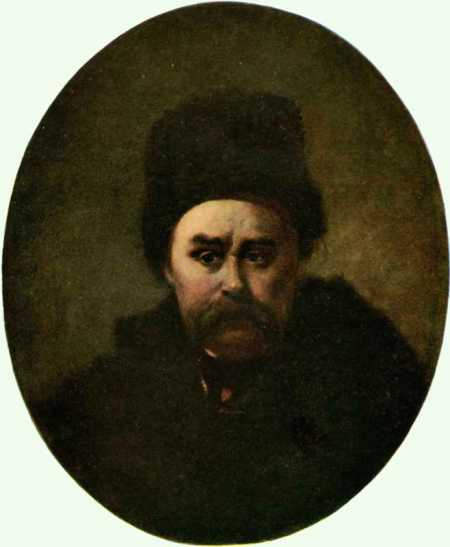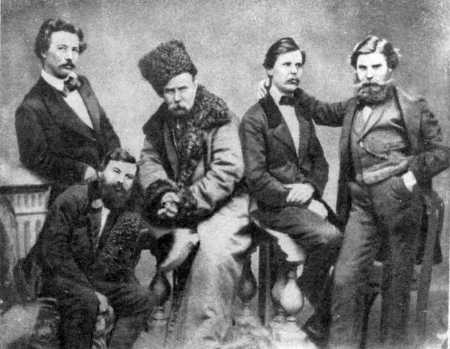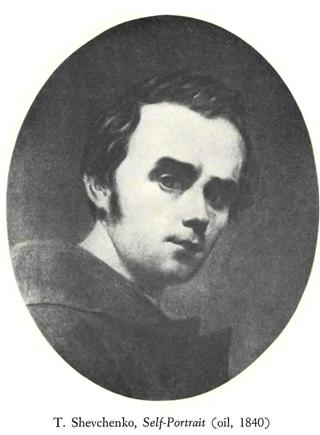TARAS SHEVCHENKO’S LIFE AND WORK
The last years of Taras Shevchenko's life (1859 - 1861)
(part of the biography written by C. H. Andrusyshen)
(Introduction of "The poetical works of Taras Shevchenko. The Kobzar" by Constantine Henry Andrusyshen and Watson Kirkconnell)

Taras Shevchenko,
"Self-portrait, 1861"
On August 13, 1859, Taras Shevcenko left Kiev, his dream to get married there brought to naught for the time being. That urge, however, did not diminish, and he continued to plead with his friends in Ukraine to continue their efforts to find him a suitable bride. To his relative Vartolomiy he entrusted the task of making a choice of some pleasant spot on a hillock along the Dnieper's bank where a comfortable house might be built for him and his future mate, and even supplied the money for the purchase of construction material.
On his return to St. Petersburg on September 7, Shevchenko was pleasantly surprised to learn that, as a result of his successful experimentation in the eau forte method, he had been appointed academician, a rank equivalent to a full professorship at the Academy of Art. Another pleasant surprise was that the officialdom was ready to allow his former poems to be printed, but with certain reservations which were to be decided by the censorship board. It would have now appeared that Shevchenko lacked for nothing — except a wife.
To the forty-five-year-old Shevchenko this matter took on real urgency. He might have fairly easily married an educated city woman, but preferred a simple village type, such as Kharitia Dovhopolenko, a serf, who worked in Vartolomiy's household as a maid, and whom Shevchenko had met only once, and that casually. To that effect he wrote Vartolomiy, asking him by all means to persuade the young woman, some twenty years his junior, to give her consent. After about nine months of inquiries, vain attempts, and false hopes, Shevchenko was informed that Kharitia was not willing, under the pretext that the suitor, besides being much older than she, was too great a pan (gentleman) for a humble woman like her.
The matter of the publication of his collected poetical works was finally settled, although the censors had to a certain extent mutilated some of his poems. About six thousand copies of the collection were printed and appeared in January 1860 under the title of The Kobzar, which pleased Shevchenko greatly, for the moral and material uplift he derived from it was considerable. For his close and trusted friends he supplied the deleted passages by inserting them on separate pages. What added to his gratification was the reaction of the Russian critics who this time, on the whole, proved more favourably disposed to his works than their older counterparts had been some two decades earlier.
Another project, to which Shevchenko devoted much attention and attached great importance, was his work on the “Bukvar” (a primer for elementary schools). For him this was a labour of love, and when it was published early in 1861, he boasted about it as if it were a monumental work. Of small literary value, the handbook none the less contributed to the pedagogical resources in Ukraine, where the dearth of just such teaching material was then acute, as the Ukrainian language was prohibited in schools.
During the two years before his death Shevchenko wrote sporadically, but not copiously. The shorter poems and lyrics he produced were not on the par with his former verve, but the same thoughts and ideals were voiced in them as he continued to defend the downtrodden against their oppressors and to preach brotherhood and fraternal unity. Some poems are autobiographical, impressed with his disappointment at his marriage plans going awry; others are based on biblical themes or written in imitation of certain passages from the Hebrew prophets which he could relate to the political and social conditions prevailing in Ukraine and to her future destiny. Among these the poem “Mary” stands out most prominently. In it Shevchenko masterfully depicts the image of the Mother of Christ in a manner that is quite unconventional. The matter of the Annunciation, Conception, and other highlights in her life are treated realistically, at times naturalistically, yet with such a pious approach and prayerful attitude that Mary's sainthood does not suffer; in fact, it increases into a divinity, for Shevchenko revealed that it was through her solicitous, blessed motherhood that she assisted the Saviour to effect His mission during His life, and continued it by influencing His disciples, after His death, to bear His ideals to the ends of the world. In its idealistic appeal the poem is certainly of universal significance.

Taras Shevchenko among friends. Photo.
The last year of his life was marked by another attempt on his part at matrimony. This final venture centred around another bond- woman, Lykera Polusmak, who was barely literate, plain-looking, and somewhat indifferent as to her reputation. However, she was fairly intelligent, and her vivaciousness appealed to Shevchenko to such an extent that he proposed to her, hoping that she was redeemable and that he himself would be able in a short time to bring her up in good behaviour and improve her mind. Eager for security and greedy for gifts, Lykera was not averse to his advances, and even sent a petition to her master to allow her to marry Shevchenko. During his intimate conversation with her, however, he discovered that emotionally she was cool towards him, did not in the least appreciate his idealistic attitude towards her, and accepted his proposal merely for selfish reasons, to get as much out of him as she possibly could. Although he now felt convinced that it would be hopeless to alter her nature by seeking to educate her, his plans to marry her did not change.
The matter became quite serious, and Shevchenko did not spare money for her trousseau, including jewellery. A month before the marriage date, he had her brought to St. Petersburg and placed in an apartment in care of an elderly lady. There he visited her almost every day, preparing her for her new occupation as a housewife, going so far as to engage a private tutor to teach her the three R’s. This “romance” which lasted about a month and a half, however, was to end tragically for the poet, for the stubborn character of Lykera did not change, and she continued in her lax ways even to the degree of seducing the tutor. Although Shevchenko felt the hurt keenly, in his blind infatuation, he was willing to forgive and forget, but she, sensing that the situation was beyond repair, told him frankly that she did not love him and had been only humouring him in order to secure for herself the life of a well-to-do lady. To a conciliatory note he sent her a little later she replied coarsely that she would have nothing to do with him henceforth, and thus broke off their relations completely. This episode was one of the most disastrous of his life, and there is good reason to believe that the resulting despondency more rapidly hastened his approaching end.
Just about that time Shevchenko was formally installed as an academician. The title was proclaimed ceremoniously under the blare of trumpets and drum rolls, as it was considered the highest recognition for one’s artistic attainments. This honour, however, failed to alleviate the poet’s depression. Surrounded by a host of friends and well- wishers, he felt utterly lonely. He tried to forget his misery by plunging into his artistic work, but to no avail.
He grew more irritable, his nervous condition assumed dangerous proportions, and he began to lose grip on himself. His spleen he vented on all and sundry, the higher the personage the more bitterly, at that moment particularly on the wife of Nicholas I, Oleksandra, who had just died, and whom Shevchenko could not forgive for being the cause of his long exile. On the least provocation, he would burst into unrestrained vituperation against Peter I, Catherine II, and others who by their oppressive measures contributed to the destruction of the Ukrainian people and their statehood. Such outbursts, reflected in the poems he then wrote, of course had a deteriorating effect on his physical constitution, and it became quite apparent that unless he exerted control over himself, he could not last long.
Towards the end of November 1860 he was examined medically and ordered to bed for a long clinical treatment. His impatience, however, proved to be his worst enemy, and his addiction to rum of course did not improve his lung ailment which he now felt quite painfully. On Christmas Eve he left his bed of sickness and went out to visit his friends to celebrate the feast by carolling and carousing. This proved the last straw, and the dropsy from which he was suffering began to progress rapidly.
Being of strong physical frame, Shevchenko might have lived to a ripe old age, in spite of the hardships and illnesses he suffered throughout his life. Unfortunately, he neglected himself by often overindulging in the sheer bohemianism of a carefree artist. His extreme passion for work, without healthful relaxation, increased his tension to the degree of exhaustion and drew his emotions out of bounds. Lack of self-control was therefore the chief deleterious factor that brought him down at the age when life could still be enjoyed tolerably well.
His final weeks, when he was almost completely bed-ridden, were occupied with plans for distributing his Bukvar and for arranging for the proceeds from its sales to be transmitted for the support of Sunday schools which were then being established in the villages for the general education of both children and adults. Even on his death bed he was still dreaming of a cottage overlooking the Dnieper, and sent instructions to Vartolomiy to forget the sites then under consideration and to try to buy him a patch of land on an elevated location near the town of Kaniv, as if he had foreseen that that would be his final resting place. In his last poem, written with a trembling hand two weeks before his death, he addressed his Muse and prepared for the long journey with her to the nether world where, on the banks of the Styx he would finally build himself a dwelling and live there with her as his wife. His earthly course almost over, there remained nothing for him but to suffer and wait for the inevitable end, which came on February 26, 1861, one day after his forty-seventh birthday. The dropsical fluid had reached his lungs. In spite of that impasse to his breathing, he insisted on getting down to his studio on a lower floor. He did not reach it. On the landing his heart, however strong, gave out and he dropped dead. He would have been overjoyed, if he had lived a week longer, to hear the proclamation announcing the abolition of serfdom in the Russian Empire.
His mortal remains were transferred to the Academy church nearby, where two days later a funeral service was held attended by a vast concourse of his fellow-artists and friends. From there the mournful procession moved to the Smolensky cemetery where, after ten orations (seven in Ukrainian, two in Russian, and one in Polish), he was interred. The one in Polish, delivered by the student W. Choro- shewski, was characteristic of the fraternal attitude of the more enlightened Poles towards the great man who, as his poetic works were understood by them, dealt harshly with the Polish ruling classes for having oppressed his people when they held sway in Ukraine, but who had always longed for good neighbourly relations with the Polish people (as well as with all the other peoples) on the basis of equality and brotherly justice. Similarly was Shevchenko, the man and the artist, dealt with by most of those who wrote about him on the occasion of his death. In far-away England, Charles Dickens, whom Shevchenko respected as a great writer and humanitarian, added his words expressing his sorrow at the loss of a fellow-craftsman whose views he shared.
Shevchenko's resting place in St. Petersburg was temporary. To honour his wish to be buried in Ukraine in a spot overlooking the nieper, it was decided on the very day of his death to seek permission t0 transfer his remains to his native land. Two months later this was granted, and Shevchenko's body was exhumed and the casket containing it placed in a massive tin coffin. After a farewell ceremony, again attended by a huge throng, it was entrained for Moscow. From there it was to proceed to and through Ukraine on a specially ordered and well-coiled oxen-drawn carriage.
It was a mournful but triumphant cortège. Before it reached Kiev, it stopped at several points on the way where religious and civil ceremonies were held and valedictories delivered. In Kiev, however, all orations were forbidden; but more eloquent than any eulogy was the gesture of a certain lady who placed on Shevchenko's coffin, as it lay in a church, a wreath of thorns. Following the service there, his body was transported on a barge down the Dnieper to the nearby town of Kaniv where on the Monk's Hill (Chernecha Horn) he was laid to his final rest. Over his grave a mound was heaped and on top of it was fixed an oak cross which two decades later was replaced by a wrought-iron one. In 1939 the Communist government of Ukraine removed it and, instead, erected a tall statue of the poet placed on a high, obelisque-like base.
Ever since Shevchenko was laid in that pleasant patch of Ukraine, his burial mound has remained a place of pilgrimage for all Ukrainians. With the exception of Mecca and Stratford-on-Avon, perhaps no other spot on earth has been a greater drawing force to a people than the grave of that greatest of Ukrainians whose flaming words roused in his race the never-to-be extinguished longing for an independent nationhood.
Introduction written by Professor C.H. Andrusyshen
Source: The Poetical Works of Taras Shevchenko. The Kobzar. Translated from the Ukrainian by С.H. Andrusyshen and Watson Kirkconnell. Published for the Ukrainian Canadian Committee by University of Toronto Press, 1964. Toronto and Buffalo. Printed in Canada, Reprinted, 1977, p. 41- 46.
Read more:

Introduction of "The poetical works of Taras Shevchenko. The Kobzar" by Constantine Henry Andrusyshen and Watson Kirkconnel.


